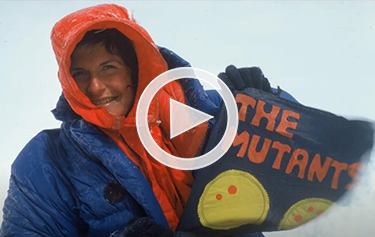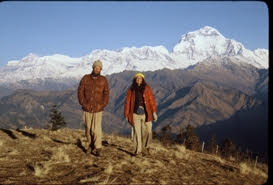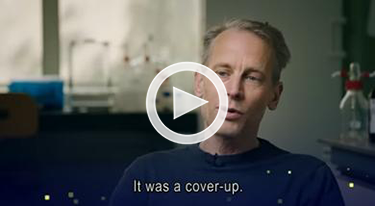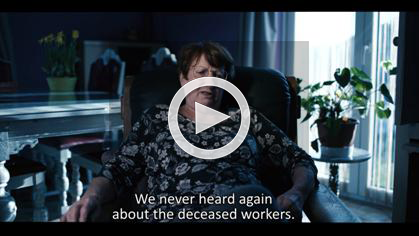October 2023 Newsletter: Nepal for the Holidays?
Hello!
| I hope you are enjoying the fall foliage and softening sunlight. Here at the Green Science Policy Institute, we are celebrating our 15th year of reducing harmful chemicals in everyday products based on science. We are encouraged by our progress, but there is still much to do. Current projects include updating regulations so harmful flame retardants are no longer needed in cars, tents, and other products, supporting alternatives to PFAS in clean energy, and preventing the unnecessary use of antimicrobials.
This December I am looking forward to returning to Nepal for a trek with spectacular views of the Himalayan giants of the Annapurna range. Get in touch if you’d like more information about possibly joining this scenic adventure. Also, there is one opening to join me on a snorkeling and/or scuba trip based at the Misool eco resort to explore the rich undersea reefs of Raja Ampat, West Papua, Indonesia in November 2024. Unfortunately, a lot of clothing worn to trek or climb mountains like Annapurna can contain PFAS. As these chemicals provide water and stain repellency, they have been considered essential for outdoor clothing, but they are often not needed. Last month I enjoyed sharing my favorite mountaineering and science stories with employees from the leading outdoor gear company Marmot. Following legislation banning PFAS in textiles, Marmot and other outdoor industry companies are innovating away from these harmful forever chemicals. You can find examples of outdoor jackets and other products without PFAS on our PFAS-free list. Also, you can watch my talk here. While you’re on the Green Science Policy YouTube channel, you can also view an inspiring plenary talk by our University of Toronto colleague Miriam Diamond. In this solutions-oriented presentation, she details a path forward to protect people and our planet from harmful chemicals. Solutions include a hard cap to prevent growth in chemical production, stopping the increase in the number of chemicals produced that exceeds the possibility of ever assessing them for harm, and working towards “sufficiency” or people being content with having enough material goods. Our need to acquire more goods is a root cause of our polluted bodies and world, according to Miriam. In other encouraging news, certain former presidents and presidential candidates are making notable progress on health and environmental challenges. Former President Jimmy Carter’s long-term goal was to outlive the Guinea worm which plagued 3.5 million people when he began his campaign to eradicate this dreaded disease. Jimmy Carter just turned 99 and there are now only a half dozen cases left in the world, so it looks like he’s been successful. An inspiration! Meanwhile, after helping to retire nearly three-quarters of the country’s dirty coal burning power plants, Michael Bloomberg is now putting his resources toward blocking new petrochemical plants. These plants threaten our climate and our health, particularly in low-income communities adjacent to the plants. Can you imagine if all other former presidents and candidates focused on benefiting society? Finally, California Governor Gavin Newsom has until October 14 to sign the No Toxics Tent Act (AB 267), allowing manufacturers of camping and children’s tents to stop using harmful flame retardants. If you’d like your tents to be both fire safe and healthy, please take a couple minutes right away to contact Gov. Newsom and urge him to sign AB267 (instructions here). Thank you for your interest and contributions to our efforts to reduce toxic harm. Warm regards, Arlene |
Flame Retardants Beware! Out of Our Couches!With Halloween coming up, here’s a spooky couch graphic from years past. The skulls represent the toxic flame retardants that were added to furniture foam beginning in 1976 to meet an ineffective California furniture flammability standard called TB117. You can learn more in an informative Retro Report from the New York Times. After years of research and advocacy by our Institute and others, California updated its furniture standard in 2014 to increase fire safety without the need for flame retardants in foam. And in 2021, this updated California standard was adopted as a federal furniture flammability standard for the whole country. Great news for both health and fire safety! However, some flame retardant manufactures and test labs are continuing to support open flame standards likely to be met once again with harmful flame retardants. Such standards can delay ignition times for a few seconds and can also increase smoke production and fire toxicity. The industry message that fire deaths have increased in California since the adoption of our new standard is based on wildfire deaths! The number of fire deaths associated with upholstered furniture is unchanged. Right now the United Kingdom is evaluating whether to update their furniture flammability standard that leads to the use of high levels harmful chemicals. Comments can be submitted until October 24th—get in touch with Anna@GreenSciencePolicy.org if you would like to help. |
Annapurna Holiday Trek: December 14-28, 2023In December, friends and I are planning a scenic trek in the shadow of the Annapurna range in Nepal. We will also explore the ancient shrines and towns of the Kathmandu Valley. Forty years ago, I led the first American climb of Annapurna I, considered among the most difficult of the world’s high mountains, and then I walked through this region on my ten month long Great Himalayan Traverse. Get in touch if you’d be interested in joining us for this walking adventure. If you are planning your own trip to Nepal, our easy and fun Nepalese language course is now free to download. Three hours of audio instruction are accompanied by a written text. Learning some Nepalese before your trip shows your respect for the people and culture of this ancient Himalayan land. If this Nepalese course is helpful, please consider making a donation to Virtue’s Children Nepal, which educates and cares for disadvantaged children in Nepal. Finally, if you need an outstanding guide and outfitter for your own trip, I’d recommend the excellent company of my long time guide and friend Chandra of Himalayan Icefall Trekking. To plan a trip customized to your interests, abilities, and timing you can contact Chandra at himtrekzone@gmail.com. |
Keeping our Pets Safe from Chemical HarmFrom squeaky toys to disposable food containers and poop bags, plastics are abundant in the pet care industry. Unfortunately, these materials and their chemical ingredients can be harmful to dogs, cats, rabbits, and more. Earlier this year, the Plastic Pollution Coalition hosted a webinar on mitigating these harms. Arlene was a panelist in addition to veterinarian Dr. Marty Goldstein and Pooch Paper founder Tracy Rosensteel. Arlene’s advice included avoiding spot-on flea treatments that can expose your pets and family to pesticides such as fipronil and imidacloprid. They can get washed down the drain and harm aquatic food webs in bays, streams, and lakes. The best way to avoid flea and tick problems is to use oral medications and clean your home well to remove flea larvae and eggs. For more good ideas on safer pet products check out information from the San Francisco Dept. of the Environment here. You can watch the full webinar recording here. |
Valuable Research on PFAS Harms Should be Publicizedby Rebecca Fuoco Though PFAS make headlines daily, our recent peer-reviewed paper reveals that most studies finding links between PFAS exposure and human health harms are published without a press release and receive little or no media coverage. We also found that studies without any press attention receive fewer scholarly citations. We analyzed 273 peer-reviewed epidemiological studies on PFAS human health impacts with publication years 2018-2020, as collected by the PFAS-Tox Database. Of papers reporting notable health harms, those with a press release received 20 times more media attention than those that did not. However, less than 8% of these papers issued a press release. Papers without press releases included studies reporting significant links between PFAS exposure and ovarian and breast cancers, osteoporosis, risks of preterm birth, and gestational diabetes. If you’re a scientist who wants to increase the reach and impact of your work, please see our communication webpage with videos, templates, and additional resources. |
Great Videos on PFAS Industry DeceptionThe Dutch public broadcast show Zembla recently aired a powerful one-hour investigation into DuPont’s coverup of PFAS harm in The Netherlands. Pouring over internal documents, they found that the chemical giant has known since the 1990s that it has Similarly, we recommend watching a Belgian public broadcast investigation into Solvay. Though less publicized than 3M and DuPont factories, the Solvay plant in Spinetta Marengo, Italy releases 200 tons of perfluorinated gases into the air each year.
|
Green Science Policy Institute in the Newsby Rebecca Fuoco Below are recent news articles, blogs, podcasts, newsletters, and more that have featured Arlene’s work based on our communications strategy:
|
CalendarOctober 18, 2023: 4:00pm Central: November 27, 2023, 12:45–1:45pm Eastern: December 6, 2023 |








